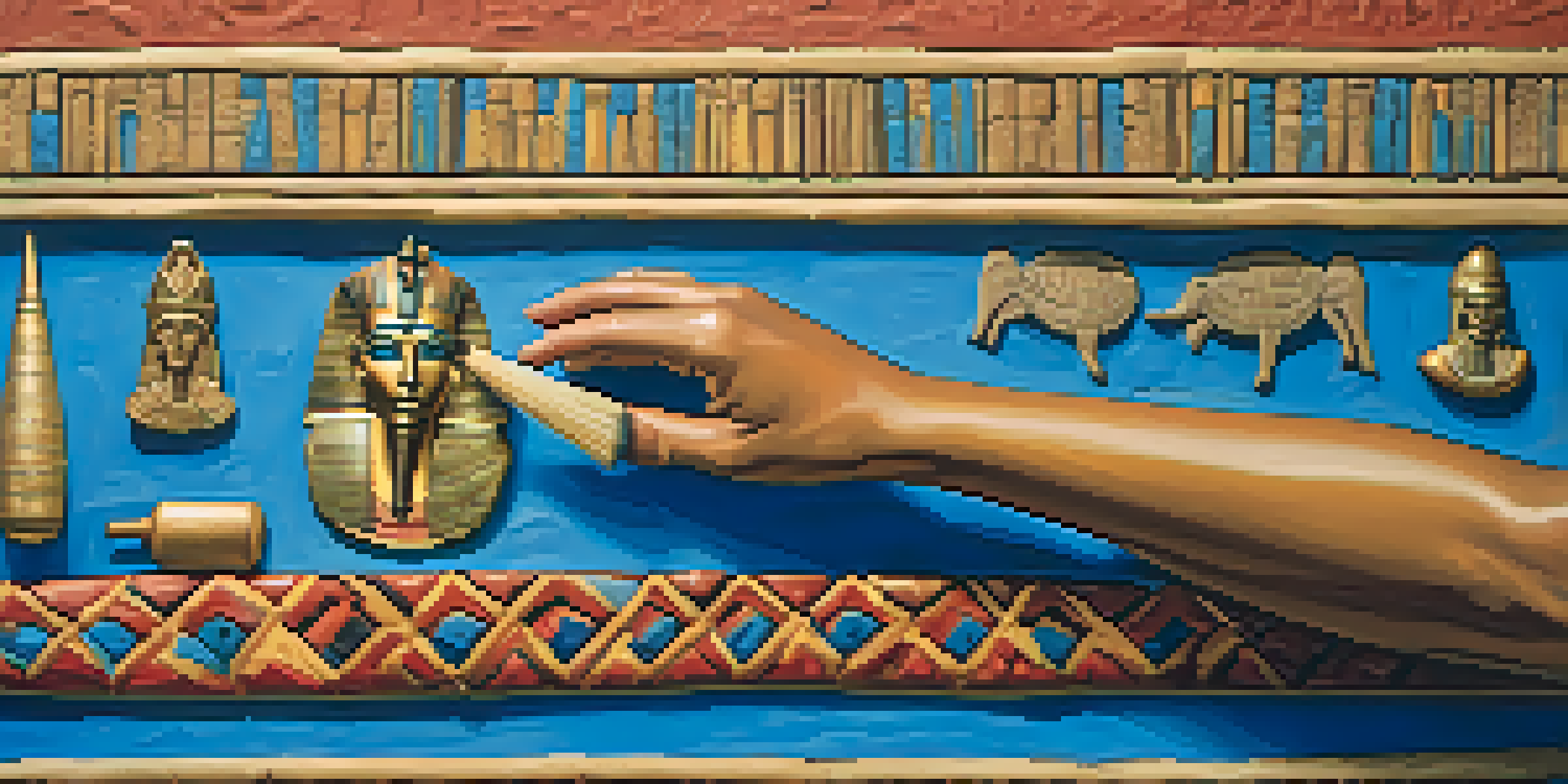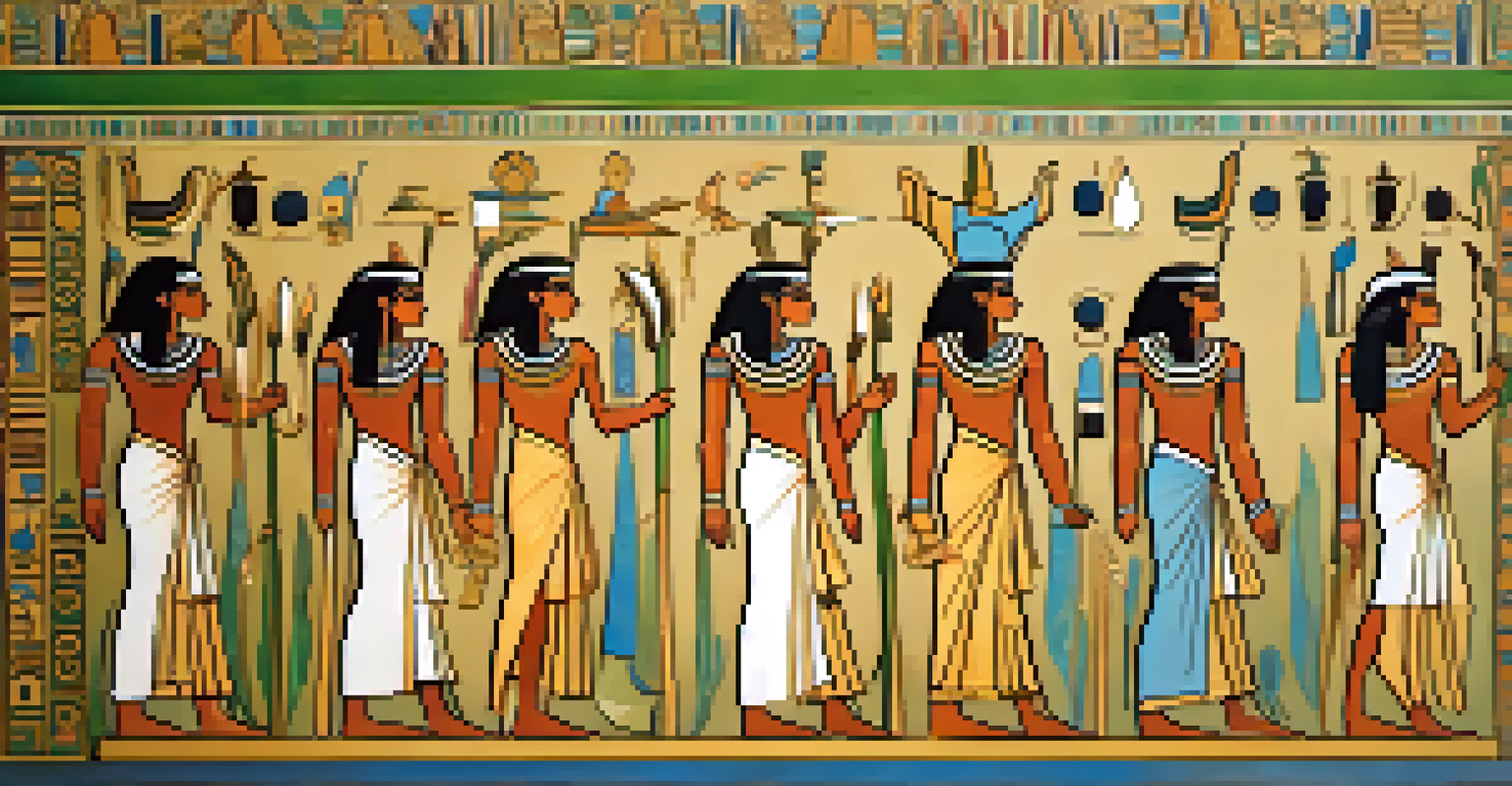The Influence of Ancient Egypt on Painting Tools

The Origins of Painting Tools in Ancient Egypt
Ancient Egypt is often hailed as one of the cradles of civilization, and its influence extends into various artistic domains, particularly painting. The Egyptians developed an array of tools to create their vivid artworks, using materials readily available in their environment. Brushes made from reeds and animal hair were common, allowing artists to achieve precise strokes and intricate details. This early innovation laid the groundwork for the tools we still use today, linking past and present in the world of art.
Art is the most beautiful of all lies.
Pigments were another significant aspect of Ancient Egyptian painting. They created colors by grinding minerals and mixing them with binders like gum or water, leading to a vibrant palette that included shades of blue, red, and yellow. These colors were not just aesthetically pleasing; they also carried symbolic meanings in Egyptian culture. For instance, the color green symbolized fertility and rebirth, illustrating how their art was deeply intertwined with their beliefs and daily life.
This combination of tools and pigments allowed Egyptian artists to produce murals that have stood the test of time, showcasing scenes of daily life, religious ceremonies, and the afterlife. The techniques and materials they pioneered are still relevant today, influencing modern painting practices and the development of new tools. As we explore the history of painting tools, it becomes evident that Ancient Egypt's legacy is a fundamental chapter in the story of art.
Materials and Techniques Used in Ancient Egyptian Art
The materials used by ancient Egyptian painters were remarkably innovative for their time. They primarily utilized natural resources, such as clay, minerals, and organic materials, which they transformed into tools and pigments. For instance, they ground ochre, a natural clay pigment, to create a range of colors, demonstrating their understanding of the environment and its potential for artistic expression. This resourcefulness is a hallmark of their artistic legacy, showing how necessity can drive creativity.

Techniques such as fresco painting, where pigments were applied to wet plaster, allowed the colors to bond with the walls, creating durable artworks that have survived millennia. This method not only showcased their skill but also reflected their architectural sophistication. The precision and detail in these murals reveal a sophisticated understanding of light, shadow, and perspective, principles that continue to inform contemporary painting techniques.
Ancient Egypt's Innovative Tools
The Egyptians developed advanced painting tools and techniques, such as reed brushes and fresco methods, which laid the groundwork for modern artistic practices.
By studying these ancient methods, modern artists can gain insights into sustainable practices and the importance of materials in art. The connection between the tools of the trade and the resulting artwork emphasizes how essential material knowledge is even today. As we look back at these techniques, we see a timeless dialogue between artist and medium that shapes the evolution of painting tools.
Symbolism in Ancient Egyptian Colors and Tools
In Ancient Egypt, color was not merely an aesthetic choice; it was steeped in symbolism and meaning. Each color represented specific concepts, with blue symbolizing the heavens and fertility, while red often stood for chaos and disorder. This intentional use of colors allowed artists to convey deeper narratives within their works. Understanding this symbolism provides valuable context when analyzing ancient paintings and the tools used to create them.
Every artist dips his brush in his own soul, and paints his own nature into his pictures.
The tools themselves also carried symbolic weight. For instance, the use of specific brushes and palettes was often linked to the status of the artist or the purpose of the artwork. High-status individuals typically commissioned works, and the tools used in these pieces reflected their wealth and social standing. This relationship between tool and artist highlights how art was not just a personal expression but also a social commentary.
Today, artists continue to explore the symbolic potential of colors and tools in their work. The legacy of Ancient Egypt serves as a reminder of the power of visual language, where every brushstroke and hue can tell a story. As modern artists experiment with new materials, they remain connected to this rich history, using symbolism to engage viewers in meaningful ways.
The Transition of Egyptian Techniques to Other Cultures
The artistic innovations of Ancient Egypt did not remain isolated; they influenced various cultures across the Mediterranean and beyond. As trade routes expanded, the techniques and tools developed by Egyptian artists were shared with neighboring civilizations, such as the Greeks and Romans. This exchange of ideas led to the evolution of painting styles and practices, demonstrating the interconnectedness of ancient cultures.
For example, the use of pigments and the concept of fresco painting spread from Egypt to other regions, where artists adapted these methods to suit their own cultural narratives. The Greeks, fascinated by Egyptian art, incorporated similar techniques but added their unique stylistic elements. This blending of influences enriched the artistic landscape of the time, showcasing how collaboration can lead to innovation.
Symbolism in Colors and Art
Colors in Ancient Egyptian art held deep symbolic meanings, influencing both the narratives depicted and the status of the artists.
Today, we can trace many painting practices back to these ancient exchanges. The tools and techniques that originated in Ancient Egypt laid the foundation for artistic developments across cultures, illustrating a shared human desire for expression. This historical journey underscores the importance of cultural exchange in the evolution of art, reminding us that creativity knows no borders.
Modern Painting Tools Inspired by Ancient Egypt
Fast forward to today, and you'll find that many modern painting tools owe their existence to the innovations of Ancient Egypt. The simple brush, for instance, has evolved, but its origins can be traced back to those early Egyptian reed brushes. Contemporary artists may now use synthetic materials, but the fundamental principles of brush design and use remain rooted in ancient practices.
Even the pigments we use have their roots in ancient methods. While modern technology allows for a broader range of colors and more stable formulations, the basic idea of mixing minerals to create vibrant hues has not changed significantly since the days of ancient Egyptian artists. This continuity highlights the enduring legacy of their craftsmanship and creativity.
Additionally, the symbolic use of color continues to resonate in modern art. Artists often draw upon the emotional and cultural meanings associated with colors, much like their ancient predecessors. As we utilize advanced tools and mediums, the influence of Ancient Egypt serves as a reminder of the deep connections between past and present artistic practices.
The Role of Preservation in Understanding Ancient Techniques
Preservation plays a crucial role in our understanding of ancient Egyptian painting techniques and tools. The arid climate of Egypt has helped to preserve many artworks, allowing modern scholars and artists to study these historical pieces. By examining how these artworks were created and maintained, we gain valuable insights into the materials and methods used by ancient artists.
Archaeological discoveries, such as ancient palettes and brushes, further enhance our understanding of the tools employed by Egyptian painters. These artifacts provide tangible connections to the past, revealing how artists approached their craft. As researchers continue to uncover these remnants of history, they contribute to a more comprehensive picture of ancient art practices.
Cultural Influence on Art Evolution
The techniques and tools from Ancient Egypt significantly influenced neighboring cultures, showcasing the interconnectedness of artistic traditions.
Moreover, the study of preservation techniques informs contemporary artists about the importance of care and maintenance in their own work. By learning from the past, modern artists can make informed decisions about the materials they choose and how to preserve their own creations for future generations. This ongoing dialogue between ancient and modern practices enriches our appreciation of art across time.
Conclusion: The Enduring Legacy of Ancient Egyptian Art
The influence of Ancient Egypt on painting tools and techniques is profound and far-reaching. From the simple reed brushes to the vibrant pigments, the innovations of Egyptian artists continue to resonate in the modern art world. Their techniques not only shaped their own culture but also laid the foundation for artistic practices across civilizations.
As we explore the legacy of Ancient Egypt, it becomes clear that their approach to art was not just about aesthetics but also about storytelling and cultural expression. The symbolic meanings behind colors and tools remind us of the power of art to convey complex ideas and emotions. This understanding enriches our appreciation of both ancient and contemporary art forms.

Ultimately, the conversation between ancient and modern practices highlights the enduring relevance of these early innovations. As artists continue to draw inspiration from the past, they contribute to a dynamic and evolving narrative that honors the creativity and ingenuity of those who came before us. The legacy of Ancient Egyptian art is a testament to the timeless nature of human expression.